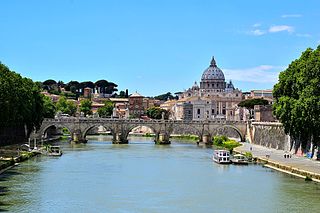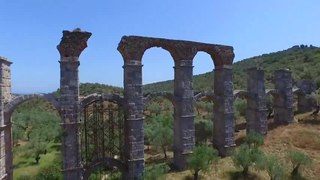
The Tiber is the third-longest river in Italy and the longest in Central Italy, rising in the Apennine Mountains in Emilia-Romagna and flowing 406 km (252 mi) through Tuscany, Umbria, and Lazio, where it is joined by the River Aniene, to the Tyrrhenian Sea, between Ostia and Fiumicino. It drains a basin estimated at 17,375 km2 (6,709 sq mi). The river has achieved lasting fame as the main watercourse of the city of Rome, which was founded on its eastern banks.
Sextus Julius Frontinus was a prominent Roman civil engineer, author, soldier and senator of the late 1st century AD. He was a successful general under Domitian, commanding forces in Roman Britain, and on the Rhine and Danube frontiers. A novus homo, he was consul three times. Frontinus ably discharged several important administrative duties for Nerva and Trajan. However, he is best known to the post-Classical world as an author of technical treatises, especially De aquaeductu, dealing with the aqueducts of Rome.

Subiaco is a comune (municipality) in the Metropolitan City of Rome Capital, in the Italian region of Latium, 40 kilometres (25 mi) from Tivoli alongside the River Aniene. It is a tourist and religious resort because of its sacred grotto, in the medieval St. Benedict's Abbey, and its Abbey of Santa Scolastica. It is one of I Borghi più belli d'Italia. The first books to be printed in Italy were produced here in the late 15th century.

The Via Valeria was an ancient Roman road of Italy, the continuation north-eastwards of the Via Tiburtina from Tibur. It probably owed its origin to Marcus Valerius Messalla, censor in 154 BC. A second Via Valeria, the Via Valeria of Sicily, connected Messina and Siracusa on the island of Sicily.

Latium Adjectum or Adiectum or Latium Novum was a region of Roman Italy between Monte Circeo and the river Garigliano, south of and immediately adjacent to Old Latium and included with it under the Roman Empire.

The Romans constructed aqueducts throughout their Republic and later Empire, to bring water from outside sources into cities and towns. Aqueduct water supplied public baths, latrines, fountains, and private households; it also supported mining operations, milling, farms, and gardens.

Aqua Anio Novus was an ancient Roman aqueduct supplying the city of Rome. Like the Aqua Claudia, it was begun by emperor Caligula in 38 AD and completed in 52 AD by Claudius, who dedicated them both on August 1.

Aqua Claudia was an ancient Roman aqueduct that, like the Aqua Anio Novus, was begun by Emperor Caligula in 38 AD and finished by Emperor Claudius in 52 AD.

The Aqua Julia is a Roman aqueduct built in 33 BC by Agrippa under Augustus to supply the city of Rome. It was repaired and expanded by Augustus from 11–4 BC.

Latium is the region of central western Italy in which the city of Rome was founded and grew to be the capital city of the Roman Empire.

The Aqua Tepula is an ancient Roman aqueduct completed in 125 BC by censors Gnaeus Servilius Caepio, who had served as consul in 141 BC, and Lucius Cassius Longinus Ravilla.

Ancient Roman technology is the collection of techniques, skills, methods, processes, and engineering practices which supported Roman civilization and made possible the expansion of the economy and military of ancient Rome.
The Via Sublacensis was a Roman road constructed to connect Nero's palace in present-day Subiaco to Rome, splitting off from the Via Valeria near Varia, about 10 km northeast of Tivoli.
De aquaeductu is a two-book official report given to the emperor Nerva or Trajan on the state of the aqueducts of Rome, and was written by Sextus Julius Frontinus at the end of the 1st century AD. It is also known as De Aquis or De Aqueductibus Urbis Romae. It is the earliest official report of an investigation made by a distinguished citizen on Roman engineering works to have survived. Frontinus had been appointed Water Commissioner by the emperor Nerva in AD 96.

The Aqua Marcia is one of the longest of the eleven aqueducts that supplied the city of Rome. The aqueduct was built between 144–140 BC, during the Roman Republic. The still-functioning Acqua Felice from 1586 runs on long stretches along the route of the Aqua Marcia.
The Subiaco Dams were a group of three Roman gravity dams at Subiaco, Lazio, Italy, devised as pleasure lakes for Emperor Nero. The biggest one was the highest dam in the Roman Empire, and even in the world until its accidental destruction in 1305.

Quintus Marcius Rex was a Roman politician of the Marcii Reges, a patrician family of gens Marcia, who claimed royal descent from the Roman King Ancus Marcius. He was a maternal great-grandfather of Julius Caesar.

The Aqua Anio Vetus was an ancient Roman aqueduct, and the second oldest after the Aqua Appia.


















